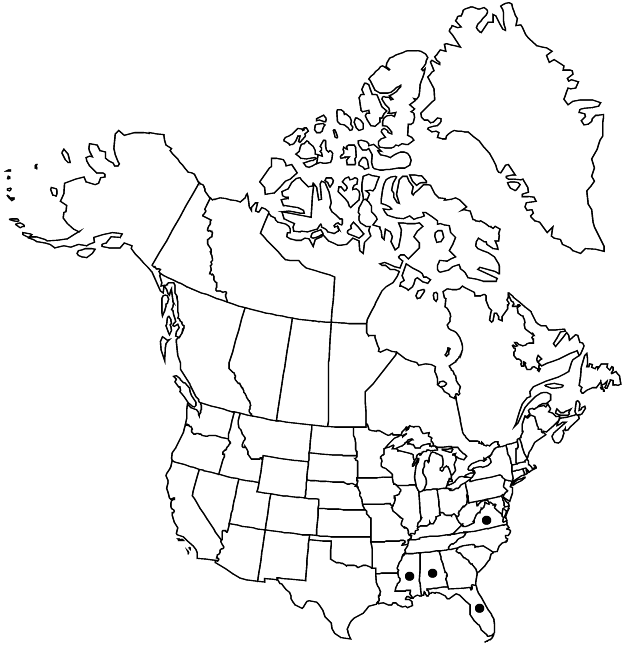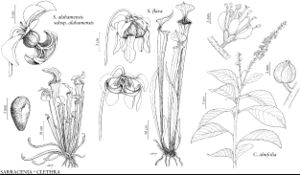Sarracenia alabamensis
Sida 21: 2169. 2005 ,.
Plants forming sparse or dense clumps; rhizomes 0.5–1.5 cm diam. Pitchers marcescent, appearing with flowers, decumbent or erect, monomorphic or trimorphic (rarely dimorphic), dull green or yellow-green, often becoming suffused with bronze to red, major veins of distal pitcher tube maroon to red-purple on internal surface, indistinctly colored on external surface, without white areolae, 8–72 cm, soft, external surface densely fine-pubescent, wings 0.3–1.5 cm wide; orifice oval, 0.7–6.7 cm diam.; rim yellow-green, rarely red, loosely revolute, with prominent everted indentation immediately distal to wing forming spout over wing; hood recurved adaxially, held well above and covering orifice, dull green to yellow-green, suffused with bronze to red, veins of abaxial surface indistinctly colored, veins of adaxial surface, if colored red, colored on main veins only, colored portion only sometimes extending distal to proximal 1/2 of hood and neck, without white areolae, ovate, undulate, 0.8–9 × 0.8–8.8 cm, longer than wide, base cordate, neck 0.5–1.5 cm, apiculum 1–3 mm, adaxial surface glabrate or with hairs to 0.5 mm. Phyllodia usually absent, sometimes erect or decumbent, oblanceolate, 15–20 × 1–2 cm. Scapes 1–2, 14–57 cm, ± equaling pitchers; bracts 0.4–1 cm. Flowers moderately fragrant; sepals maroon-green, 2–3 × 1–2 cm, (margins strongly reflexed abaxially after anthesis); petals maroon, distal portions obovate, 2.5–4 × 1.2–2.8 cm, margins erose; style disc green, 2.5–4 cm diam. Capsules 0.6–1.2 cm diam. Seeds 1.2–1.5 mm.
Distribution

Ala., Fla., Miss., Va.
Discussion
Subspecies 2 (2 in the flora).
The taxonomy of the Sarracenia rubra complex is controversial. The complex may be viewed as having three species, S. alabamensis, S. jonesii, and S. rubra, two of which have subspecies, as we present here; or it may be viewed as one species, S. rubra, with five subspecies. Our circumscription of taxa in the complex is based on field, garden, and greenhouse observations of all of the taxa. The five taxa have practically identical flowers and can produce pitchers whose diagnostic features may not always be clear cut due to response to the environment. Confusion may also arise when hybrids occur, or when plants are stressed.
We feel that Sarracenia jonesii is more closely related to S. rubra; both have pitchers that are firm-textured, glabrous or merely puberulent, and with distinct dark red or maroon tissue and vein coloration on both internal and external pitcher surfaces and abaxial and adaxial hood surfaces, and both generally grow in wetter habitats. Sarracenia alabamensis, on the other hand, has pitchers that are relatively softer, always pubescent, and dull green to yellow-green with bronze to red flush on distal pitchers and hoods, and less distinct red to maroon veins on the internal surface and hood surfaces. Its greatest difference from the other taxa in the complex is the trimorphic pitchers of S. alabamensis subsp. alabamensis.
We believe that an ancestral form arose in the uplands of the southern Appalachians, migrated southward along major rivers, and, upon reaching the emerging coastal plain, could have spread eastward and southward with little change from its mountain ancestor to give rise to the forms of Sarracenia rubra in the Carolinas, Georgia, and western Florida, while S. jonesii remained in the low mountains of the western Carolinas. On the other hand, we see S. alabamensis as having been isolated from ancestral mountain stock and moving southwestward via the Coosa River into the Alabama fall line sandhills. From there, it gave rise to a coastal plain form, subsp. wherryi. Thus, from late Cretaceous ancestral stock of the southern Appalachian Mountains, populations migrated into the newly formed coastal plain to their present locations, became discontinuous during Tertiary geological events, and produced the three variable but closely related species. All five taxa are allopatric with respect to each other. Designating them all as subspecies of S. rubra obscures their significant differences and evolutionary patterns.
Selected References
None.
Key
| 1 | Pitchers trimorphic; early spring pitchers decumbent or declined, usually sigmoidly curved (S-curved); late spring pitchers erect, yellow-green, 18-50 cm; summer pitchers erect, yellow-green, 19-72 cm; orifices 0.7-6.7 cm diam.; hoods of summer pitchers 0.8-9 × 0.8-8.8 cm; scapes 27-57 cm; Fall Line Hills, c Alabama. | Sarracenia alabamensis subsp. alabamensis |
| 1 | Pitchers monomorphic; spring and summer pitchers erect, dull green, 8-48 cm; orifices 0.7-4.2 cm diam.; hoods 0.8-4.6 × 0.8-5.4 cm; scapes 14-40 cm; extreme sw Alabama just n of Mobile Bay and immediately adjacent Mississippi and Florida. | Sarracenia alabamensis subsp. wherryi |
"winged" is not a number."variable" is not a number.
